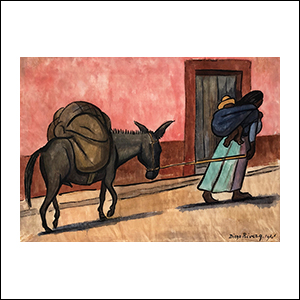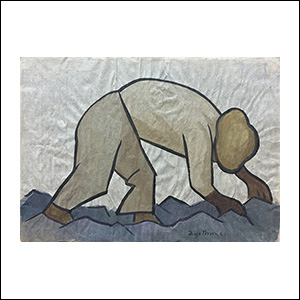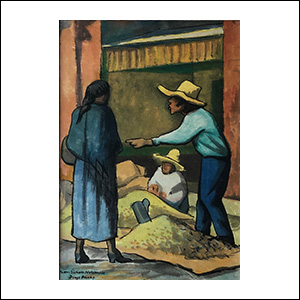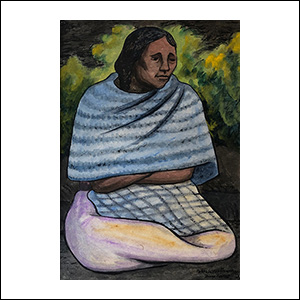Diego Rivera
Guanajuato, 1886 - Mexico City, 1957
DIEGO RIVERA - BIOGRAPHY
Diego Rivera was a Mexican painter considered one of the three most important muralists in Mexico, along with José Clemente Orozco and David Alfaro Siqueiros; as well as one of the most internationally recognized artists of the 20th century.
Diego Rivera was born on December 8, 1886 in the City of Guanajuato. His family moved to Mexico City in 1892. From the age of three he began to draw and at the age of ten he began studying art courses at night at the Academia de San Carlos. In 1898, he won a scholarship that allowed him to register at the Academia de San Carlos as a regular student. Some of his main teachers were José María Velasco, Félix Parra and Santiago Rebull. In 1902, he received another monthly scholarship from the Governor of Veracruz, Teodoro A. Dehesa, who liked to support and promote art. At that time, Diego Rivera and other young students at the academy were influenced by the ideas of Gerardo Murillo (later known as Dr. Atl), who had just returned from Europe and used to talk to them about the avant-garde currents in Europe. Diego Rivera began to draw and paint not only in the studio but outdoors. He finished his studies at the Academia de San Carlos in 1905, and began receiving a government allowance.
In 1906, Diego Rivera was part of Savia Moderna, a group in favor of modernism made up of young artists, architects, writers and intellectuals, who published a magazine of the same name. In May of that year, Diego Rivera participated in the exhibition organized by Savia Moderna and Dr. Atl, which emphasized the modern European styles of impressionism, symbolism, and art nouveau. That same year Diego Rivera lost his government allowance, however Governor Teodoro A. Dehesa awarded him a scholarship to study four years in Europe on the condition that he send him a work every six months to demonstrate his progress. He also participated in the San Carlos Academy exhibition that year with twelve works, and thanks to the efforts of Dr. Atl, several of his works were sold, which allowed him to pay for his passage to Europe.
Diego Rivera arrived in Spain on January 6, 1907, with a letter of introduction that Dr. Atl had provided for the renowned realist painter Eduardo Chicharro y Agüera, who took Rivera as his student and after six months qualified his progress as surprising. Interested in the painting of the masters, Rivera studied the works of Goya, El Greco, Velázquez, Brueghel, Cranach and Bosch from the Prado Museum. During this period, he also formed a friendship with the painter María Gutiérrez Blanchard. In 1909, Rivera moved to the Hotel de Suisse in Paris, worked at the Montparnasse Academies and in the open air along the Seine River. In the summer he visited Bruges where he met Angelina Beloff, who would later become his concubine. In 1910, he studied with the academic painter Victor-Octave Guillonet and traveled to Madrid to prepare his next exhibition at the Academia de San Carlos in Mexico, with the works he had made in Europe. He traveled to Mexico for the exhibition that was inaugurated by the wife of President Porfirio Díaz, Mrs. Carmen Romero Rubio de Díaz, just two days after the beginning of the Mexican Revolution. The exhibition was a success both socially and economically. Díaz's wife bought six of the works and the government bought another seven.
Diego Rivera returned to Paris again in June 1911, a few days after the resignation of President Porfirio Díaz. Rivera and Angelina Beloff began to live together. He befriended Amadeo Modigliani with whom he used to visit the cafes of Montparnasse. In the spring of 1912, Diego Rivera and Angelina traveled to Toledo. He formed a friendship with another of the Mexican artists who had emigrated to Paris, Angel Zárraga, together they studied the art of El Greco and Ignacio Zuloaga. In the autumn, he returned to Paris and took up residence at 26, rue de Départ, where the studios of the Montparnasse artists were located. Rivera met with Mexican artists living in Paris at the time, including Angel Zárraga, Dr. Atl, Roberto Montenegro, and Adolfo Best Maugard. He began to be influenced by the cubism of his neighbors, the Dutch painters Piet Mondrian, Conrad Kikkert, and Lodewijk Schelfhout, who had developed their style from the study of Cézanne's painting. The year 1913 marked Diego Rivera's transition to Cubism, first through his study of El Greco and later through the assimilation of Cézanne's characteristics. During this period, which lasted until 1917, Rivera produced approximately two hundred paintings. He formed a very close friendship with artists Robert Delaunay, Fernand Léger, and Marc Chagall.
In April 1914, Diego Rivera presented his first solo exhibition in Paris at the Berthe Weill Gallery, after having participated in several group exhibitions previously. He toured Spain together with Angelica Beloff, Jacques Lipchitz, Berthe Kristover and María Gutiérrez Blanchard making sketches along the route. While they were camping on the island of Majorca, the First World War broke out. The group moved to Madrid and presented their works in the exhibition Los pintores íntegros, organized by the Spanish writer Ramón Gómez de la Serna, which introduced cubism to Madrid in 1915. Rivera and Beloff returned to Paris in the spring.
In August 1916, Angelina Beloff gave birth to Rivera's son. Diego Rivera's work was included in two group exhibitions of Post-Impressionist and Cubism art at Marius de Zayas's Modern Gallery in New York. In October, said gallery presented Rivera's first solo exhibition in New York along with pre-conquest art. Rivera signed a two-year contract with the art dealer Léonce Rosenberg and emerged as an important figure within the Cubist “crystal” or “classic” group, which included Gino Severini, André Lhote, Juan Gris, Jean Metzinger and Jacques Lipchitz. However, Rosenberg broke relationship with Rivera in March 1917, after Rivera and Pierre Reverdy, the most prominent critic in Paris, engaged in an argument that leaded to actual physical violence. Rivera was ostracized by Braque, Gris, Léger and others, as well as by his close friends Lipchitz and Severini. A month later he left Beloff and went to live with the Russian emigrant artist Marevna Vorobëv-Stebelska, however, six months later he returned with Beloff. In the fall of 1918, her son fell ill and died from the Spanish flu epidemic. Rivera and Beloff moved from Montparnasse to an apartment on the Champs des Mars far from the artistic and intellectual circle of Montparnasse. Marika, daughter of Marevna Vorobëv-Stebelska and Diego Rivera, was born in November 1919.
In 1920, Alberto J. Pani, the Mexican ambassador to France, at the suggestion of the rector of the University of Mexico, José Vasconcelos, urged Diego Rivera to go to Italy to study Renaissance art in the hopes that Rivera could establish a philosophy of public art that will be adequate for postrevolutionary Mexico. Rivera leaves for Italy and for the next seventeen months he studies Etruscan, Byzantine, and Renaissance art, especially the works of Giotto, Uccello, Mantegna, Tintoretto, Piero della Francesca, and Michelangelo. José Vasconcelos was named Minister of Education and with this he began a vast popular education program, including the painting of murals in public buildings.
Diego Rivera left Paris and Angelina Beloff. He arrived in Mexico in July 1921 to join the Vasconcelos mural program. He began to paint Mexican themes and develop the classic figurative style that would later appear in his murals. In 1922, he began painting his first mural, La Creation, in the Bolivar Amphitheater of the National Preparatory School. In June of that year, Rivera married Guadalupe Marin. A few months later, Siqueiros, Diego Rivera, Carlos Mérida, Amado de la Cueva, Ramón Alva Guadarrama, Xavier Guerrero, Fernando Leal, Fermín Revueltas, and Hernán Queto, with the help of José Clemente Orozco, formed the Union of Workers, Painters, and Sculptors. His manifesto proclaimed, in part, "We repudiate the so-called easel painting, and all the art of ultra-intellectual circles, because it is aristocratic and we glorify the expression of Monumental Art because it is a public possession." Broadsheets printed and distributed by the union developed into a newspaper, El Machete, which eventually became the journal of the Mexican Communist Party. Diego Rivera joined that party at the end of the year.
In 1923, Diego Rivera began painting the murals for the Secretaria de Educación Pública, which took him four years and three months working up to 18 hours a day. It was a huge program, 117 fresco panels covering an area of almost 1,600 square meters. Tina Modotti and Edward Weston traveled from Los Angeles to Mexico and visited the murals. They met Rivera and became friends. In 1924, Rivera began his murals in the administration building at the National School of Agriculture in Chapingo. Articles about Diego Rivera's murals began to appear in the United States, which began to attract a steady stream of artists, intellectuals, and collectors from that country to Mexico to watch Rivera work on the murals for the Secretaria de Educación Pública. In this year his first daughter, Guadalupe, was born from his marriage to Guadalupe Marin.
Following the advice of Bertram Wolfe, Diego Rivera left the Mexican Communist Party in 1925, declaring that he could better dedicate himself to Marxism through his art than as a militant. That same year his painting Flower Day was included in the Pan-American exhibition at the Los Angeles Museum, and won the acquisition award. He also became the art editor of Frances Toor's Mexican Folkways magazine.
In 1927, Diego Rivera fell from a scaffold in Chapingo and was rendered unconscious. For three months he was convalescing with head injuries. His second daughter, Ruth, was born, however it was also the year in which he permanently separated from Guadalupe Marin. He became an active member of the Anti-imperialist League of the Americas, as well as director of its publication, El Libertador, and president of the Workers and Farmers Bloc. In September of the same year, he traveled to the Soviet Union as part of the official Mexican delegation for the celebration of the tenth anniversary of the October Revolution. He was appointed Master of Monumental Painting by the Moscow School of Fine Arts. During his stay in the Soviet Union he signed a contract with Anatoly Lunacharsky, Soviet Commissioner of Education and the Fine Arts, to paint murals for the Red Army Club, which he was unable to do as he was plagued by incompetent assistants, established academic artists who conspired against him; and also due to a sinus infection that caused him to be hospitalized. He worked closely with Octobre, a group of Moscow artists who advocated a public art form based on the Russian folk tradition that promoted socialist ideals; they opposed both socialist realism and the abstract art of the Soviet avant-garde. Diego Rivera's association with Octobre influenced his later works of public art. The Stalin government asked him to return to Mexico in June 1928, due to Diego Rivera's differences with the regime.
Upon his return to Mexico, Diego Rivera met Frida Kahlo at one of the weekly parties offered by Tina Modotti, and decided to portray her together with Siqueiros, Modotti, and the communist Cuban refugee Julio Antonio Mella in his mural Distributing Arms in the Secretaria de Educación Pública. In April 1929, he was appointed Director of the Academia de San Carlos, a position he held for one year. A few months later, he began his mural Historia de la Nación de México on the main stairway of the Palacio Nacional, and married Frida Kahlo in Coyoacán. He also began painting a mural at the Palacio de Cortés in Cuernavaca, commissioned by the United States Ambassador, Dwight W. Morrow, as a gift from the United States to the state of Morelos.
In mid-November 1930, Diego Rivera traveled to San Francisco, California, to begin work on his mural Allegory of California at the New Stock Exchange Club in San Francisco, and the opening of his first retrospective exhibition, which was held at the California Palace of the Legion of Honor. He also made the mural The Making of a Fresco at the California School of Fine Arts.
Rivera returned to Mexico in June 1931 to continue his murals. With the resources of his sales in the United States, he began the construction of a house and studio in the San Angel section of Mexico City, a project carried out by the architect and painter Juan O'Gorman. In December of the same year, Riveras’s retrospective exhibition was presented at the Museum of Modern Art in New York, the second one person show held at the MOMA, the first being that of Matisse.
In April 1932, Rivera and Kahlo traveled to Detroit. Rivera visited and drew sketches from the Ford Motor Company plant for the mural that he would make at the Detroit Institute of Art, which began in June and ended in March of next year. Later he was commissioned for the elaboration of the mural Man at the Crossroads Looking with Hope and High Vision to the Choosing of a New and Better Future, also known as The Man Controller of the Universe or Man at the Crossroads, for the RCA Building (Radio Corporation of America) in New York. Raymond Hood, the project architect, approved the mural's design, but when Rivera visited the site he drastically altered the approved design. The result was an explicit critique of the bad of capitalism and the good of socialism. Nelson Rockefeller asked Rivera to replace the face of Lenin on the mural with that of an unknown person, to which Rivera replied that he could substitute the face of Abraham Lincoln and other nineteenth-century American figures for a group of individuals opposite Lenin, and stated that instead of mutilating his conception, he preferred the physical destruction of the mural completely, but preserving, at least, its integrity. The firm that administered the RCA project fired Rivera, prompting political protests that were covered by the national and international press. The mural was covered with canvas painted to match the adjoining wall. A few days later, the General Motors company canceled a mural that Rivera was commissioned to make in the corporation's building.
A month later, Diego Rivera agreed to paint a series of twenty-one fresco panels for the mural Portrait of America, of the Communist Party Opposition (anti-Stalinist) at the New Workers School in New York, which was directed by his friend and future biographer Bertram D. Wolfe. He also made the October Revolution and IV International murals (a political organization formed by Trotsky in opposition to Stalin) for the Communist League of America, a Trotskyite center in New York. Upon completion, they returned to Mexico on December 20.
The RCA murals were destroyed in February 1934. A few months later Rivera began to paint a smaller reproduction of these murals at the Palacio de Bellas Artes in Mexico City.
In late 1935, Alberto Misrachi became Rivera's representative, also serving as his mentor, accountant, and banker for a decade. In the summer of 1936, Diego Rivera made four murals: Dance of the Huicholobos, Agustín Lorenzo, the satiric Touristic and Folkloric Mexico, and political caricature of contemporary Mexico, The Dictatorship, for the recently inaugurated Hotel Reforma by Alberto Pani. The Dictatorship included portraits of well-known politicians, religious, and businessmen. Pani and his associates reacted by painting out some of the images, which caused Rivera to sue him. Rivera won, and he was allowed to restore the work, which was later put into a warehouse and finally sold to Alberto Misrachi. A few months later, the writer Anita Brenner wrote to Rivera asking if Rivera could get Mexico to grant immediate political asylum to Leon Trotsky. Rivera and his political colleague Octavio Fernández contacted President Lázaro Cárdenas, who agreed to give Trotsky refuge on the condition that Trotsky engage in no political activities during his stay in Mexico. Leon and Natalia Trotsky arrived in Tampico on January 9, 1937, and they stayed to live in the Riveras’ home in Coyoacan, which was reinforced against attacks and protected by Trotsky's supporters.
In 1938, André and Jaqueline Breton arrived in Mexico. First they stayed at Guadalupe Marin's home, and then with the Rivera family at their home in San Angel. The Riveras, Bretons and Trotskys socialized and used to travel together. Breton fell in love with Frida Kahlo's work and offered to organize an exhibition of her work in Paris. In the August-September issue of the Partisan Review, Trotsky praised the art of Diego Rivera; then in the fall issue, Breton and Rivera signed the article Manifesto: For a Free Revolutionary Art, which was in fact written by Trotsky. Later personal and political conflicts developed between Diego Rivera and Trotsky, leading Trotsky to announce in early 1939 that he no longer felt moral solidarity with Rivera's anarchist ideas. In a short time, Trotsky moved out of Rivera’s home.
Rivera and Kahlo divorced in late 1939. Diego continued to live in the San Angel home-study and continued to see Frida frequently. From 1937 to 1941, Rivera did not receive mural projects from Mexico, which allowed him to paint a large number of easel works. During this period, he produced only the mural Unidad Panamericana, which he painted live at the Golden Gate International Exposition in 1940, in San Francisco, California. During the exhibition, Rivera received the news of Trotsky assassinated by Spanish Stalinist Ramón Mercader, and shortly after Frida Kahlo arrived in San Francisco to reconcile with Rivera. They remarried on December 8, 1940. It was until 1942 when Rivera began a series of murals about the pre-Conquest cultures on the second floor of Palacio Nacional, completing in this year the panels of the Tarascan Civilization and the Zapotec Civilization. In this year, Rivera began the construction of the Anahuacalli, a monumental building that would serve as a museum to house his personal collection of pre-Columbian art with about sixty thousand pieces, the largest private collection that existed in Mexico. Rivera worked on the construction of the Anahuacalli intermittently for the rest of his life, and it was after his death that its construction was completed.
Diego Rivera began teaching composition and painting classes at the Escuela Nacional de Pintura y Escultura (La Esmeralda) in 1943. He was a member of the faculty for a long time, and made various murals in the following years, including: History of cardiology, at the Instituto Nacional de Cardiología (1943); another in the Ciro’s nightclub at Hotel Reforma (1943); The Great City of Tenochtitlán, in Palacio Nacional (1945); Dream of a Sunday Afternoon in the Alameda Central, for the Hotel del Prado (1947-48), it was relocated to the Museo Mural Diego Rivera after the 1985 earthquake; the murals Totonaca Civilization and Huasteca Civilization, in Palacio Nacional (1950); the murals The Cocoa Harvest, The Maguey Industry, and The Disembarkation of the Spaniards in Veracruz, in Palacio Nacional (1951); The History of Theater in Mexico, on the facade of the Teatro de los Insurgentes (1953): The People in Demand for Health, at Hospital de la Raza (1953); and the transportable mural Río Juchitán (1954-1956).
In 1946, Emma Hurtado became his representative. In 1949, the first retrospective of his work in Mexico, Diego Rivera: 50 years of his artistic work, was inaugurated by President Miguel Alemán at the Palacio de Bellas Artes. More than a thousand works were exhibited. In 1950, Frida Kahlo was admitted to the hospital for operations on her spine. She remained hospitalized for about a year, so Rivera took a room next to her and spent most nights there. That same year the Mexican government awarded Rivera the National Prize for Visual Arts. Frida Kahlo died on July 13, 1954. A year later, Diego Rivera married Emma Hurtado and they traveled together to Russia, Prague and Poland. Upon his return to Mexico, Diego Rivera received a national homage for his 70 years of life.
Diego Rivera died on November 24, 1957 in his San Angel studio in Mexico City.
(Sources: 1. Diego Rivera, A Retrospective, texts by Laurence P. Hurlburt, Jorge Hernández Campos, Alicia Azuela, Ida Rodríguez-Prampolini, Betty Ann Brown, Francis V. O'Connor, Luis Cardoza y Aragón, Xavier Moyssén, Rita Eder, Ellen Sharp y Stanton L. Catlin, Founder Society Detroit Institute of Arts and the Instituto Nacional de Bellas Artes, 1986)
MAIN SOLO EXHIBITIONS
|
1910 Academia de San Carlos, Mexico City |
|
1914 Galerie Berthe Weill, Paris |
|
1916 Exhibition of Paintings by Diego M. Rivera and Mexican Pre-Conquest Art, Modern Gallery, New York |
|
1925 Drawings and Mural Studies, Galerie Beaux-Arts, San Francisco |
|
1927 Sketches, Worcester Art Museum, Worcester, Massachusetts |
|
1928 Weyhe Gallery, New York |
|
1930 Works by Diego Rivera along with 1,200 Mexican art objects, Metropolitan Museum of Art, New York, and toured over the United States |
|
1930 Diego Rivera Retrospectiva (120 obras), California Palace of the Legion of Honor, San Francisco |
|
1931 Detroit Institute of Art, Detroit, Michigan |
|
1931 Diego Rivera Retrospectiva, Museum of Modern Art, New York |
|
1932 Galleries of the Society of Arts and Crafts, Detroit |
|
1938 Galería de Arte Mexicano, Mexico City |
|
1940 San Francisco Museum of Art, San Francisco, California |
|
1943 Drawings by Diego Rivera, The Hackley Art Gallery, Muskegon, Michigan |
|
1949 Diego Rivera, 50 Años de su labor artística, Museo del Palacio de Bellas Artes, Mexico City |
|
1951 Retrospective of Rivera’s Work, Houston Museum of Fine Arts, Houston |
|
1956 Obras recientes, Galería Diego Rivera, Mexico City |
|
1958 Museo Nacional de Cuba, La Habana |
|
1958 Obras de Diego Rivera, Museo Nacional de Arte Moderno, Mexico City |
|
1959 Museo Nacional de Arte Moderno, Mexico City |
|
1965 Diego Rivera, La colección de Dolores Olmedo de Olvera, Museo de Arte Moderno, Mexico City |
|
1965 Homenaje al maestro Diego Rivera, Escuela Nacional de Artes Plásticas, UNAM, Mexico City |
|
1966 Galería de Artes Plásticas, Mexico City |
|
1967 El Taller de Diego Rivera, Galerías de la Ciudad de México, Mexico City |
|
1971 Greer Gallery, New York |
|
1973 Colección Marte R. Gómez: Obras de Diego Rivera, Museo de Arte Moderno,Mexico City |
|
1977 Exposición Nacional de Homenaje a Diego Rivera, Palacio de Bellas Artes, Mexico City |
|
1981 250 Joyas de Diego Rivera, Banamex, Mexico City |
|
1982 Diego Rivera: Mural Studies, San Francisco Museum of Modern Art, San Francisco |
|
1983 Facultad de Medicina, UNAM, Mexico City |
|
1983 Museo de Monterrey, Monterrey, NL |
|
1983 Museo Rufino Tamayo, Mexico City |
|
1984 Diego Rivera: The Cubist Years, Phoenix Art Museum |
|
1984 The Mexican Museum, San Francisco, California |
|
1984 Diego Rivera, Los años cubistas, Museo Nacional de Arte, Mexico City |
|
1986 Diego Rivera, A Retrospective, Detroit Institute of Art, Detroit |
|
1986 Diego Rivera, A Retrospective, Philadelphia Museum of Art, Philadelphia |
|
1986 Diego Rivera, A Retrospective, Museo del Palacio de Bellas Artes, Mexico City |
|
1987 Diego Rivera, A Retrospective, Salas Pablo Picasso, Madrid |
|
1987 Diego Rivera, A Retrospective, Staatliche Kunsthalle Berlin, West Berlin |
|
2001 Fundación Proa, Buenos Aires, Argentina |
|
2011 Diego Rivera, Murales para el Museo de Arte Moderno, Museum of Modern Art, Nueva York |
|
2013 Frida Kahlo / Diego Rivera, El arte en fusión, Musée de l'Orangerie, París |
|
2015 Diego Rivera and Frida Kahlo in Detroit, Detroit Institute of Art |
|
2017 Diego Rivera y la experiencia en la URSS, Museo Casa Estudio Diego Rivera y Frida Kahlo y Museo Mural Diego Rivera, Mexico City |
|
2019 Diego Rivera, artista universal, Casa de México en España, Madrid |





